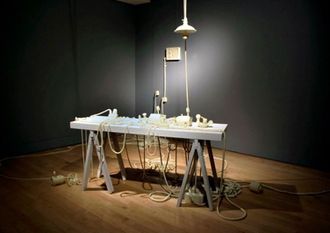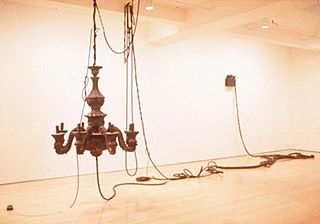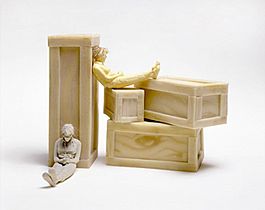Jeanne Silverthorne facts for kids
Quick facts for kids
Jeanne Silverthorne
|
|
|---|---|
| Born | 1950 Philadelphia, Pennsylvania, United States
|
| Education | Temple University |
| Known for | Sculpture, installation art |
| Awards | Guggenheim Fellowship, Joan Mitchell Foundation, Anonymous Was a Woman Award |
Jeanne Silverthorne (born 1950) is an American sculptor. She is famous for her sculptures made from cast rubber. She also creates installations, which are artworks that fill an entire room or space.
Silverthorne's art often explores the idea of an artist's studio. She sees the studio as a symbol for how artists create, the human body, and even life and death. She became well-known in New York City during the 1990s. At the time, she was part of a group of artists who used unusual materials. They challenged an older art style called Minimalism, which was known for very simple and serious art. Instead, Silverthorne used everyday materials to make personal and handmade art.
She treats the artist's studio like a place to be explored and documented. One critic said her work looks at "the end of studio arts." Another critic wrote that her art explores "deeply sad worlds, made lively by the occasional dark joke."
Silverthorne has won many awards for her work. Her art is in famous museums like the Museum of Modern Art (MoMA) in New York and the San Francisco Museum of Modern Art. She lives in New York and has taught at the School of Visual Arts since 1993.
Contents
Early Life and Career
Jeanne Silverthorne was born in 1950 in Philadelphia, Pennsylvania. She earned a degree from Temple University in 1971. She also studied at the Pennsylvania Academy of the Fine Arts. For much of the 1980s, she lived and worked in both New York City and Philadelphia. In 1988, she moved to New York for good.
Her early sculptures were often made from cast materials like hydrocal or epoxy. She made sculptures of things like prosthetic limbs, piles of messy ribbons with wind-up keys, and light bulbs. These works were often playful and looked like something from a cartoon. Critics said her art was like the work of famous artists such as Jasper Johns and Claes Oldenburg.
The Artist's Studio as Art
In the early 1990s, Silverthorne began to focus on the artist's studio. She saw the studio as an old-fashioned place, almost like a ruin. She made rubber casts of everything inside: old wires, tools, trash, and even herself.
She used rubber because it looks a bit like skin and absorbs light. She also played with size, making tiny things huge and large things very small. This made ordinary objects look strange, funny, or even a little sad. Her work explored ideas about the human body, the process of making art, and how things decay over time.
Her exhibitions in the 1990s received a lot of attention. They were often large, sprawling installations of cast rubber objects. These objects were connected by long rubber wires and cables, making the whole room look like a giant, strange machine. One show featured a huge rubber chandelier that didn't give off any light. A critic for The New York Times called another show "good creepy fun."
Another famous installation was called The Studio Stripped Bare, Again. It featured black rubber electrical cords hanging from the ceiling and spilling onto the floor. The cords all led to a single grey rubber light bulb. The light bulb, a cartoon symbol for a bright idea, was turned off. This suggested the end of old ideas about art.
Reliefs and Machines
In the late 1990s, Silverthorne created artworks that looked like close-up views of human skin. She enlarged these views, cast them in rubber, and put them in fancy black rubber frames. These pieces, called reliefs, make the human body seem like a strange and foreign landscape.
Later, she connected these reliefs to machine-like sculptures. For example, Fear Machine and Tear Machine (2002) seemed to be "emotional engines." They connected reliefs of a dry mouth or an aching body to rubber pipes and switches. These artworks were described as being both beautiful and monstrous at the same time.
In later works, she made reliefs of flowers. A 2013 exhibition at The Phillips Collection explored classic themes about the shortness of life and beauty. She placed her own sculptures, like a glowing pink flower with flies on it, next to old paintings from the museum's collection.
Self-Portraits and DNA
Starting in the 2000s, Silverthorne began to include tiny self-portraits in her exhibitions. These small figures, less than a foot tall, showed her in different poses. One sculpture shows her sitting on a cast rubber shipping crate. Another shows her as a figure that is unraveling.
She also made portraits of her family and friends using glowing rubber. These portraits often included the person's real hair and a DNA report. The DNA report could trace their family history back thousands of years. This combination of personal items like hair and industrial material like rubber raised questions about what makes a person unique.
Later Art Exhibitions
Silverthorne's more recent exhibitions combine many of her past ideas. They are thoughtful and sometimes dark, but always with a sense of humor. She has added moving parts, small scenes, and themes about nature to her work.
One show included a trash can overflowing with rubber light bulbs, called Untitled (Bad Ideas). Another piece, Pneuma Machine (2005), was a collection of small rubber appliances that would shake and move.
Her 2019 show at the Marc Straus gallery was inspired by the book Frankenstein. It explored the role of the artist as a creator. The show included dull rubber light bulbs that couldn't shine and outlets with no electricity. These objects were like the monster in the story: a perfect copy of something real, but without life.
Awards and Art Collections
Jeanne Silverthorne has received many honors for her art. She won a Guggenheim Fellowship in 2017 and a Joan Mitchell Foundation Award in 2010. She also received an Anonymous Was A Woman Award in 1996.
Her sculptures are part of major public art collections around the world. You can find her work at the Museum of Modern Art (MoMA), the San Francisco Museum of Modern Art, the Whitney Museum, and The Phillips Collection, among others.
Other sources
- Flynn, Tom. The Body in Three Dimensions, New York: Harry N. Abrams, Inc., 1998.
- Isaak, Jo Anna. Feminism and Contemporary Art, New York: Routledge, 1996.
- Seigel, Jeanne. "Eva Hesse’s Influence Today? Conversations with Three Contemporary Artists," Art Journal, Summer, 2004, p. 72–88.
- Von Hardenberg, Irene. Im Atelier, Gerstenberg Verlag, 2005.





